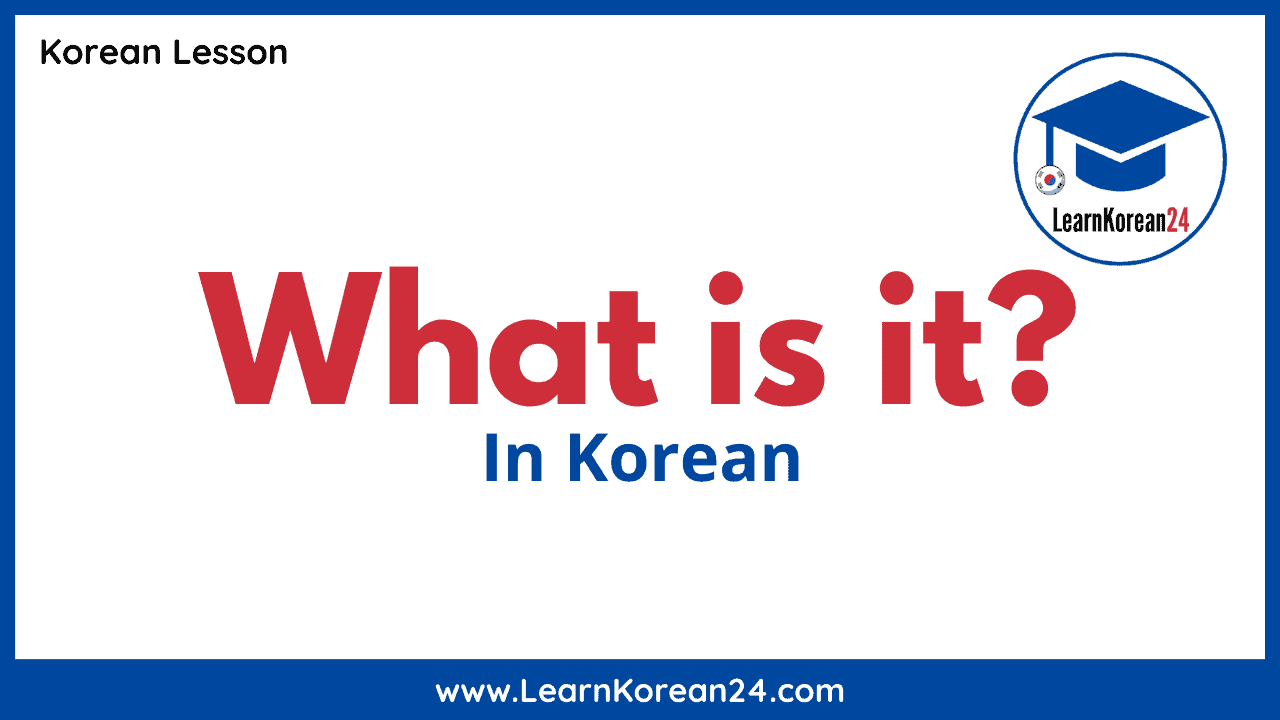How To Say ‘What is it?’ In Korean
In this lesson, you will learn how to ask and answer ‘What is it?’ in Korean. You’ll also learn an important Korean ending which will allow you to say things like ‘It’s a book.’ ‘It’s water.’, etc. The Korean words in this lesson are written in both Hangul and English. If you’ve not yet learned how to read the Korean alphabet, check out our complete Korean alphabet guide to help you learn how to read in Korean.
How To Ask ‘What is it?’ In Korean
‘What is it?’ In Korean is 뭐예요? [mwo-ye-yo?]. This is made up of 뭐, which means ‘What’ in Korean, and 예요 [ye-yo] which means ‘is’ in the sense of ‘is equals to’. So, 뭐예요? [mwo-ye-yo?] means ‘What is it?’ in Korean. Listen to the audio below to hear how to pronounce 뭐예요 [mwo-ye-yo?]
뭐예요? [mwo-ye-yo?] = What is it?
How To Answer ‘What Is It?’ In Korean
Now that you know how to ask ‘What is it?’ in Korean, let’s learn how to answer this question. To answer this question, you simply attach either ~이에요 [i-e-yo] or ~예요 [ye-yo] to a noun to make the sentence ‘It’s a (noun).’ Both of these endings are similar to ‘is’ in English in the sense of ‘is equals to’. The particular ending you choose depends on the noun which comes before it. Let’s look at how to decide whether to use ~이에요 [i-e-yo] or ~예요 [ye-yo].
If the noun ends in a consonant, add ~이에요.
If the last letter in the noun is a consonant, then you simply attach ~이에요 [i-e-yo] to the noun to make the sentence ‘It’s a (noun).’ Let’s look at an example.
- 책 [chaek] = book
- 책 [chaek] + ~이에요 [i-e-yo] = 책이에요 [chae-gi-e-yo]
- 책이에요. [chae-gi-e-yo] = It’s a book.
As you can see in the above example, the noun 책 [chaek], which means ‘book’, ends in the consonant ㄱ. So, ~이에요 [i-e-yo] was added to make 책이에요 [chae-gi-e-yo] (It’s a book).
If the noun ends in a vowel, add 예요.
If the last letter in the noun is a vowel, then you simply attach ~예요 [ye-yo] to the noun to make the sentence ‘It’s a (noun).’ Let’s look at an example.
- 바나나 [ba-na-na] = banana
- 바나나 [ba-na-na] + ~예요 [ye-yo] = 바나나예요 [ba-na-na-ye-yo]
- 바나나예요. [ba-na-na-ye-yo] = It’s a banana.
As you can see in the above example, the noun 바나나 [ba-na-na], which means ‘banana’, ends in the vowel ㅏ. So, ~예요 [ye-yo] was added to make 바나나예요 [ba-na-na-ye-yo] (It’s a banana).
You may have also noticed in 뭐예요? [mwo-ye-yo?] (What is it?) the ending ~예요 was used. Again, this is because 뭐 ends in a vowel (ㅝ).
Example Sentences
| English | Korean | Audio |
|---|---|---|
| What is it? | 뭐예요? [mwo-ye-yo?] | |
| It’s a banana. | 바나나예요. [ba-na-na-ye-yo] | |
| It’s a bag. | 가방이에요. [ga-bang-i-e-yo] | |
| It’s an apple. | 사과예요. [sa-gwa-ye-yo] | |
| It’s a school. | 학교예요. [hak-kkyo-ye-yo] | |
| It’s a pencil. | 연필이에요. [yeon-pi-ri-e-yo] | |
| It’s a T-shirt. | 티셔츠예요. [ti-syeo-cheu-ye-yo] | |
| It’s water. | 물이에요. [mu-ri-e-yo] |
“What Is It?” In Korean – Review Quiz
Review what you learned today with this fun review quiz. There are 10 questions and each question asks ‘What is it?’ in Korean. You must choose the correct answer with either 에요 or 이에요. Good luck! 🙂
Are you ready to get serious about learning Korean? Start our 100% FREE online Korean language course today!

